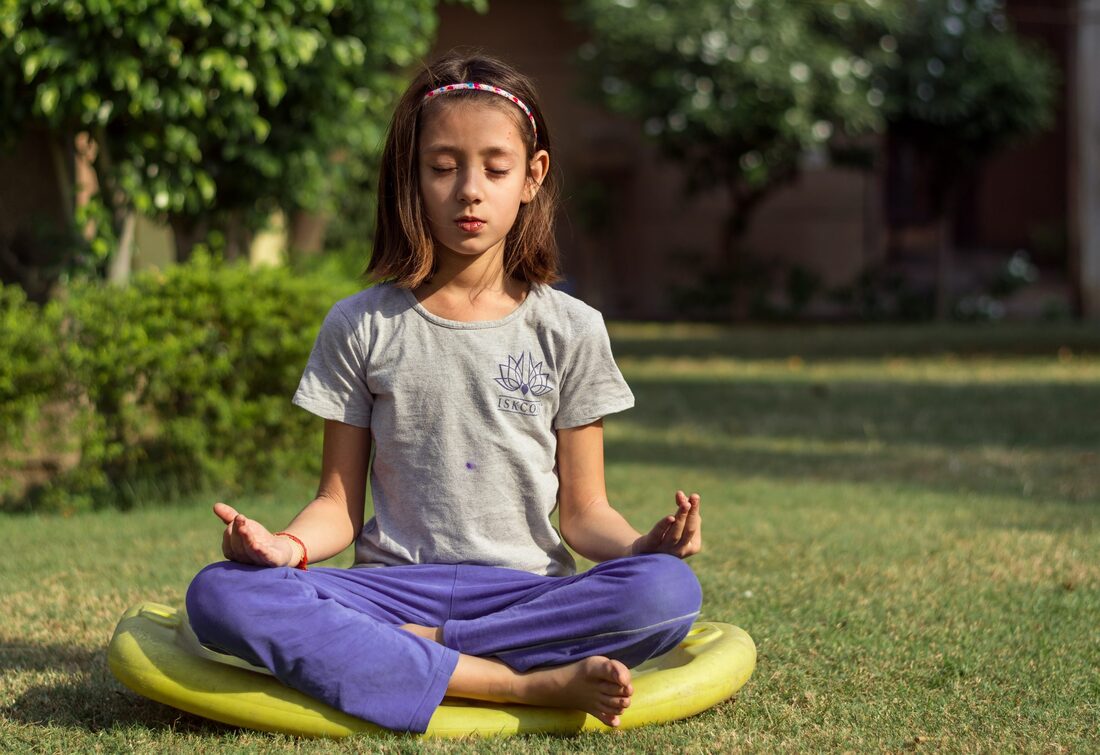Mindfulness for ChildrenThe practice of mindfulness offers a plethora of benefits to a child’s growing mind and body. Mindful practices allow them to unplug and check-in with themselves. Through this process of checking in, children begin to have a better understanding and ability to cope with their emotions and feelings. It also helps them with noticing the positives, developing a sense of appreciation, and feelings of gratitude. So, let’s talk about mindfulness for children and how parents can help teach their children to practice mindfulness (as well as improve their own mindfulness skills). Mindfulness Techniques: For When You are Short on TimeAs a busy parent, you’re likely often short on time but that doesn’t mean you have to skip the mindfulness practice. Try one of these right before bed or take a moment to pause while you’re out and about. Belly Breathing
Finger Counting Breaths
Be Aware of Your Surroundings
Mindfulness Techniques: For When You Have a Bit More TimeWhen you have a bit more time you can try one of these longer mindfulness practices for children. Draw Your Emotions
Silence Game
Tense and Release Muscle Activity
Five Senses
Mindfulness for Children and Parents: Techniques to Do TogetherOf course, mindfulness is just as important for parents as it is for children. So, while learning about mindfulness for children it’s also important to keep in mind that we should all be practicing our mindfulness techniques. Here are some practices you can do together with your children, or as a whole family. Share a three breath hug
Establish a Gratitude Practice
Yoga
Check Your ‘Personal Weather’ Report
Final ThoughtsWe talk a lot about mindfulness practices, but we rarely address specific mindfulness practices for children. Not only is mindfulness helpful for children to practice to better understand and cope with their emotions but beginning the practice at a young age helps to set them up for success as adults. Do keep in mind that not all of the practices are going to work with every child, and different practices may work depending on your child’s age and stage of development. So, give a number of these practices a try and find out which ones work best. And remember that all of these require practice.
The question:
I’ve been a very casual smoker for about 10 years – but I only do it around my friends who smoke. This ends up being about 3 cigarettes a week. There’s something about my friends smoking that triggers a mental response for me to join them. What mental strategies can I use to prevent this? I’d really like to stop. The answer: Stopping – or even cutting down – the amount you smoke can have a tremendous positive impact on your health. However, cutting down on the amount that you smoke can be challenging and frustrating, and is easier said than done. On a very positive note, the amount that you smoke is relatively little (although I would like to underscore this still can have a significant negative impact on health). The other positive thing is that you have one set of very clear triggers/cues for your smoking – friends who smoke – which increases the likelihood that you will be able to stop smoking reasonably quickly, if you put effort into adhering to effective strategies. Your smoking pattern is one where there is a strong psychological addiction, but little if any physiological addiction. The best way to target the psychological addiction is to break the behavioural patterns that are associated with your smoking. For the first few weeks, don’t change how much you smoke, change when you smoke. This is an effective strategy that may sound counter-intuitive, but works! You say you are smoking 3 cigarettes a week. So, schedule having one cigarette every other day. There are a few rules for making this effective: Only smoke at scheduled times. You do not have to smoke at a scheduled time if you do not have the urge to smoke. You cannot “save up” scheduled smoking times that you missed. The predetermined, scheduled smoke time cannot be around other people. The rationale is that you are breaking the behavioural link between a stimulus cue (friends who smoke) and your behavioural response (smoking). Also, for this first few weeks while you are implementing these strategies, make a concerted effort to not be around these friends at all so you avoid the temptation to smoke. For the subsequent few weeks, your goal is to expose yourself to the stimulus cues (friends who smoke) and actively not give in to the behavioural response (smoking). There are a few ways you can approach this. You could have your predetermined scheduled cigarette immediately before seeing your friends. You could drink/eat something that is incompatible with smoking (e.g., many people find that if they sip on a beverage such as milk or apple juice they will not want to simultaneously smoke). Once you have been able to get through these steps successfully, start to gradually reduce the number of cigarettes you are having (start with 4 maximum one week, 3 the following week, 2 the following, etc.) until you have completely eliminated smoking. Write down the reasons you want to quit smoking completely and place these reasons somewhere you can view them daily – your fridge or bathroom mirror. Actually having the reasons front and centre in your mind can have a powerful impact. Be patient. Recognize that it is hard to stop smoking (even if you are smoking a small quantity), particularly if you have smoked for years or even decades. Know that you may have some setbacks, but that you can do it. Finally, reward yourself for cutting down or stopping smoking. One way is to calculate the amount of money you are saving by smoking less, and use this money toward a purchase to treat yourself. You may also reward yourself if you meet a target goal you have set to cut down/quit smoking. Excerpted from Dr. Joti Samra’s “Ask the Psychologist” weekly column in The Globe and Mail. The question:
I’m medically obese – but totally happy with my body (I swear). Family and friends tell me there has to be something psychologically wrong with me, if I can be truly happy with my body being this large. What’s your perspective? The answer: First, there is nothing “psychologically wrong” with you for truly accepting your body as it is. You sound like a confident person whose self-esteem is not impacted by your physical appearance. The reality is there are a range of physical attributes (e.g., weight, height, facial features, acne, scarring), health conditions (e.g., cancer, HIV) and physical disabilities (e.g., paraplegia, amputations) which could impact self-esteem and confidence. Unfortunately, the stigma in our society surrounding weight issues is undeniable: I think most people view weight as something that is very much within one’s control. The reality is that there is a significant margin of control we can have over our weight through healthy diet and exercise, but some people have a stronger genetic component to their weight, and these individuals can have tremendous difficulty losing weight. You say you are “medically obese”: a body mass index (or BMI) is the measurement that is used to define individuals’ weight classification, and involves a ratio between height and weight. Individuals are classified as being “obese” when the BMI exceed 30 kg/m2. By definition, obesity is a medical condition where body fat has accumulated to the point that there may be an adverse impact on health. I wonder if the concern coming from your family and friends is related to your physical health, not your psychological well-being. There is ample evidence that obesity increases the likelihood of developing a range of serious health conditions, including: heart disease, diabetes, sleep apnea, osteoarthritis, and certain types of cancer. Overall life expectancy is also reduced. When your family or friends express their concerns to you, you may want to ask them what specifically they are concerned about, as I suspect it has much more to do with these health risks. I also wonder if it may be scary for you to acknowledge the possible negative health effects your weight is having. Stating your happiness and acceptance of your body/weight to others may possibly be a way for you to avoid facing some of the other negative impacts that exist, as those may be daunting to both face and start to take some action toward. I would suggest a conversation with either a loved one that you trust, or ideally a health professional: a physician, nutritionist, or dietitian can provide you with useful information on making some changes to your lifestyle – if that is something you feel you want to do. Excerpted from Dr. Joti Samra’s “Ask the Psychologist” weekly column in The Globe and Mail. Tips for Positive Discipline - A Guide for ParentsPositive discipline has a plethora of benefits for children, in comparison to negative discipline (e.g., spanking, hitting, reprimanding). Instead of shaming the child or making them feel bad, positive discipline focuses on misbehavior as an opportunity for learning. It’s important that parents practice positive discipline techniques so that as tensions rise, situations are still handled properly. The Core of Positive Discipline: There are no Bad Kids, just Bad Behaviour
Be Kind, but Firm
When Possible, Offer Choices
Treat Mistakes as Opportunities to Learn
Set Clear Expectations and Boundaries (and be consistent!)
Use Single Word Reminders
Let the Child Face Natural Consequences
Final Thoughts on Positive DisciplinePositive discipline helps parents to handle challenging situations with children by educating them on what to do right rather than focusing on what they’ve done wrong. Making the switch to positive discipline but with practice parents will start to see a change in their children’s behavior.
Inspired by afineparent.com/be-positive/positive-discipline.html |
PH&S ClinicEnhancing psychological health, wellness and resilience Archives
July 2024
Mental Health
All
|



 RSS Feed
RSS Feed

